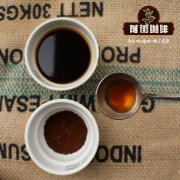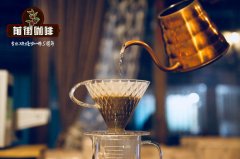Brazil Minas sun yellow bourbon coffee beans how to cook _ how to bake Brazilian yellow bourbon coffee beans?

Professional coffee knowledge exchange more coffee bean information please follow the coffee workshop (Wechat official account cafe_style)
Coffee was first introduced to Brazil in the early 18th century. In 1727, the Brazilian government sent a personable army officer to secretly bring coffee seeds from French Gaiana to Brazil on the pretext of mediating border disputes. It is said that the governor's wife of French Gayana was so fascinated by the officer that she secretly brought coffee tree seeds to him at a farewell dinner party. At present, 2 million hectares of land in Brazil is used to grow coffee, the largest is Arabica, and the beans will eventually be sent to large bakers in various countries, also known as Santos (in the name of the export port of Santos, not the producing area). Brazil has also proved to be able to produce gourmet coffee and small quantities of coffee, and the local boutique coffee can not only be provided by small-scale coffee farmers. The main coffee producing areas in Brazil are Sul de Minas South Minas, Matas de Minas Minas South East Mountain Forest, Cerrado Hirado, the north-central mausoleum of Chapadas de Minas Minas, Mogiana, Paran á Parana and Bahia Bachia. There are both traditional varieties and variants, such as Bourbon, Mondo Novo Mondonovo, Icat ú Ikatu, Kaduai, Iapar, cultivated card Taiyi.
Brazil is the largest coffee producer in the world, accounting for about 30% of coffee production, but because Brazil is located in tropical rain forest areas with relatively flat terrain and few high-altitude mountain forests, most coffee is grown in low-altitude non-volcanic soil areas. And there is not much shade for shading, resulting in the disadvantage that Brazilian beans grow quickly, but the density and soft flavor of coffee does not change much. Coupled with the large-scale machine harvesting of coffee beans with a wide range of maturity differences in coffee harvesting at the same time, the quality of Brazilian coffee beans is not particularly outstanding has always stayed in the category of commercial beans.
After 2000, due to the inducement of coffee competition, the quality of coffee beans produced in the high-altitude areas of the south was appreciated, mainly by the farms around the Minas platform, and the coffee quality was also the largest among Brazilian coffee beans, such as Sirado in the west of Minas and Matas in the east, Bashiya in the north or small farms in the south, Minas almost became synonymous with Brazilian boutique coffee. In recent years, the coffee competition is so accurate that it is separated by treatment (water treatment, half water washing, half sun drying), which has developed a variety of flavors and taste, which is completely different from that of traditional Brazilian coffee. In particular, half-sun and solarization performed best, with an increase in the aroma of clean, low-acidity fruit, reducing the rich chocolate flavor in the city of Kasuela, South Minas Gerais.
Brazilian Coffee Minas Sun Yellow bourbon Coffee Bean Baking record
(1) Brazilian beans are usually used as mamba or mixed beans. This time, they are baked with mixed beans and are expected to be baked in the middle. 190 degrees into beans. Control at 0800 degrees, the temperature is 161C, fire to 230C to incense, cool to 190C at 185C, 1030C to 199.5 °C, 1300C, 207C. (it takes 2 minutes and 30 seconds to explode to the next bean)
Originally wanted to burst 90 seconds and 210 degrees under the beans, but the time is up, the temperature has not yet arrived, to 2 minutes 30 seconds, look at the bean color check not much on the first beans.
Palate: very palatable, as for the acceptable taste of coffee, there is a little more sour flavor, a little sweetness, a little astringency, no bitterness, no great characteristics, no texture to drink, but high mellow thickness.
It turns out that this is the taste of the coffee I used to drink. Since I fell into the world of boutique coffee, I haven't had such uncharacteristic coffee for a long time. However, Brazilian spaghetti beans are very important.
(2) 12Compact 30 baking, expected to bake to medium to deep baking, with a caramel finish. It explodes at 185 degrees at 1000 and 218 degrees at 1300.
Palate: sour to scorched flavor, no miscellaneous taste, high alcohol thickness, a little astringent taste.
(3) bake at 5pm and roast at 190 degrees. 0800160 degrees, warming 210degrees to the end. An explosion of 1045196 degrees, beans under 1345222 degrees, uniform bean color, no oil.
END
Important Notice :
前街咖啡 FrontStreet Coffee has moved to new addredd:
FrontStreet Coffee Address: 315,Donghua East Road,GuangZhou
Tel:020 38364473
- Prev

How should weak acid brazilian sunburn sirado coffee be brewed? Brazilian sirado coffee bean cup test report
Professional coffee knowledge exchange More coffee bean information Please pay attention to Coffee Workshop (Weixin Official Accounts cafe_style) Brazil Coffee-Cerrado Natural 2 contains nutty aroma, delicate and clean taste. Moderate aroma, soft and smooth on the palate, with a slight sweetness at the end. Coffee Bean: Brazil Cerrado Natural 2 Scr
- Next

Red fruit boutique Brazilian San Antonio Manor Story _ what kind of coffee is suitable for Brazilian coffee beans?
Professional coffee knowledge exchange more coffee bean information please follow the coffee workshop (Wechat official account cafe_style) Brazil is currently the world's largest coffee producer-the total output in 2010 reached 48.095 billion bags, exceeding the global output of 1max 3! Coffee was first introduced to Brazil in the early 18th century, and in 1727 the Brazilian government sent a personable army officer to mediate the border.
Related
- Detailed explanation of Jadeite planting Land in Panamanian Jadeite Manor introduction to the grading system of Jadeite competitive bidding, Red bid, Green bid and Rose Summer
- Story of Coffee planting in Brenka region of Costa Rica Stonehenge Manor anaerobic heavy honey treatment of flavor mouth
- What's on the barrel of Blue Mountain Coffee beans?
- Can American coffee also pull flowers? How to use hot American style to pull out a good-looking pattern?
- Can you make a cold extract with coffee beans? What is the right proportion for cold-extracted coffee formula?
- Indonesian PWN Gold Mandrine Coffee Origin Features Flavor How to Chong? Mandolin coffee is American.
- A brief introduction to the flavor characteristics of Brazilian yellow bourbon coffee beans
- What is the effect of different water quality on the flavor of cold-extracted coffee? What kind of water is best for brewing coffee?
- Why do you think of Rose Summer whenever you mention Panamanian coffee?
- Introduction to the characteristics of authentic blue mountain coffee bean producing areas? What is the CIB Coffee Authority in Jamaica?

